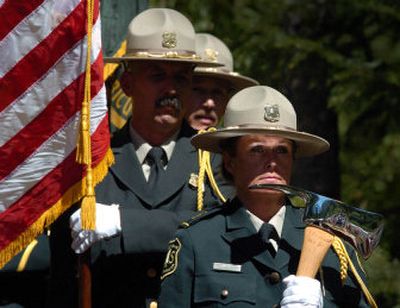Trail to mine honors Pulaski

WALLACE, Idaho – Ranger Ed Pulaski, known to be a gruff, no-nonsense woodsman, would have probably felt uneasy at Saturday’s ceremony naming a trail in his honor.
Speeches were read recounting his heroic deeds. Top dignitaries described him in mythical terms. White-gloved honor guards and a bagpiper were on hand at the mouth of the West Fork of Placer Creek.
Near the very same spot on the same date 95 Augusts ago, Pulaski and his men were running for their lives from a firestorm that unleashed as much energy every two minutes as the atomic bomb dropped on Hiroshima. The “Big Blowup” of 1910 killed at least 85 people, destroyed entire towns and burned 3 million acres along the Montana-Idaho border.
The event became the 9/11 of wildland firefighting, prompting the young U.S. Forest Service to declare total war on wildfires for the better part of the next century. On Saturday, the anniversary of the blowup, a new two-mile trail was dedicated that leads to the remnants of the mine shaft where Pulaski is credited with saving 39 of his 45 firefighters from the flames.
“History was made here,” said U.S. Sen. Larry Craig, R-Idaho, who helped secure $300,000 from Congress to pay for the trail. Another $147,000 in private funds was raised for the trail to the Nicholson Adit.
Moments after Pulaski and his crew reached the narrow, abandoned mine shaft, fire swept over the creek valley. The tunnel filled with gas and smoke. Some men panicked and cried, and others prayed, according to Pulaski’s 1923 account of the fire, which was about the only time he ever publicly described the event. One of the firefighters tried to flee, prompting Pulaski to pull his government-issued revolver and say, “The next man who tries to leave this tunnel I will shoot.”
Inside the mine, timbers caught fire. Pulaski and the crew passed out, waking hours later, burned and suffering from lung damage. Pulaski’s men actually thought he was dead, with one firefighter remarking, “Come on outside boys, the boss is dead.” Pulaski famously replied, “Like hell he is.”
The trail to the mine starts about a half-mile south of Wallace on Moon Pass Road. Construction won’t be completed until early October, but leaders of the Pulaski Project said they wanted to hold the dedication on the anniversary of the fire. A narrow, steep path had previously led to the site, but the path crossed private land and dangerous talus slopes, and the Forest Service stopped maintaining it about five years ago.
The new trail is safer, flatter and follows the bottom of the creek valley, said Jack Dorrell, the Forest Service employee who helped design the new route. “It’s going to be a nice trail, a pretty walking trail,” he said.
The Pulaski Trail also includes interpretive signs. The mine shaft where Pulaski and his men took refuge is now blocked with steel bars for safety reasons, but portions of the route pass trees that were charred in the fire.
The dedication ceremony featured a massive, burned cedar stump from the 1910 fire. A green ribbon circling the stump was cut with a holy relic of wildland firefighting: Pulaski’s own pulaski tool. The combination ax and hoe invented by Pulaski is the main tool of thousands of wildland firefighters today. The sight of the weathered tool – still razor sharp – prompted some gasps in the crowd of at least 125 people. After the ceremony, Forest Service officials posed for photos with Pulaski’s pulaski.
During the ceremony, members of the Forest Service honor guard carried shiny chrome-covered pulaskis with military-like precision and reverence. One such tool was presented at the event to Jim See, the Mullan High School guidance counselor who spearheaded the three-year effort to secure funds and build an interpretive trail to the site.
The trail is meant to honor the firefighters killed in 1910 and ensure the events of the day do not fade from memory, See said. “We honor them with this trail,” he said. “We honor all wildland firefighters past, present and future with this trail.”
The trail is central to the history of the Forest Service, which was only five years old when the fires took place, said U.S. Department of Agriculture Undersecretary Mark Rey.
“The 1910 fires gave the new agency a defining purpose: To demonstrate that destructive wildfire could be controlled and prevented,” Rey said at the dedication ceremony. “In hindsight, perhaps based on what we know now, they performed that particular task a bit too well. But upon that single achievement rests the whole practice and the entire science of sustained forest management, and that we must never forget.”
Until the Forest Service could demonstrate that fires could be controlled, the notion of replanting trees on charred land was viewed as a “fool’s errand” and not worth a dime of tax dollars, Rey added. Only recently has the federal government begun rethinking its ways. Today, the Forest Service is struggling to find a way to restore fire to the West’s overly thick forests while trying to prevent fires with the same force as those of 1910.
“We will be judged and remembered on the basis of whether, during the remainder of our watch, we meet this challenge,” Rey said.